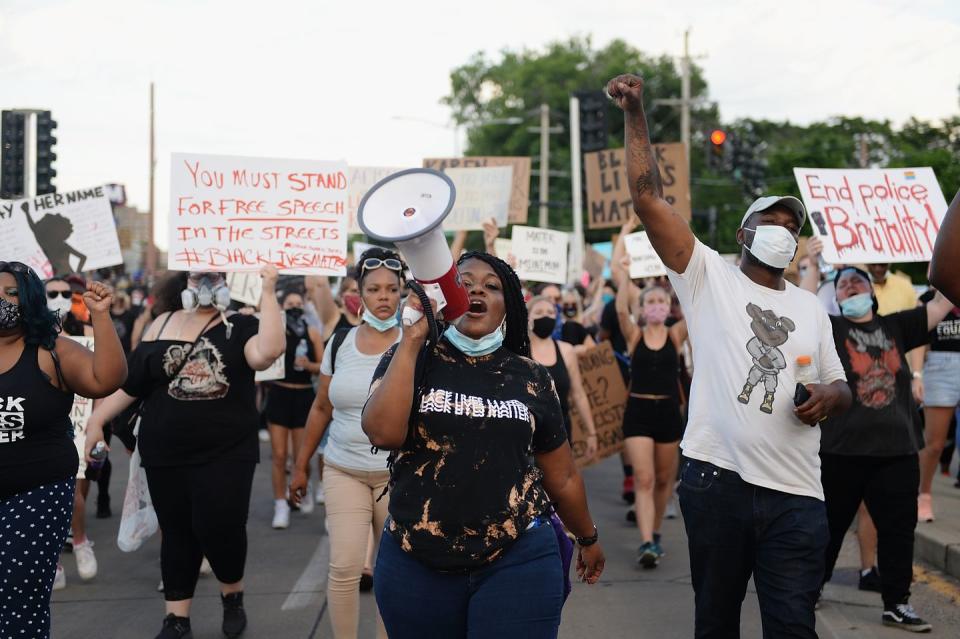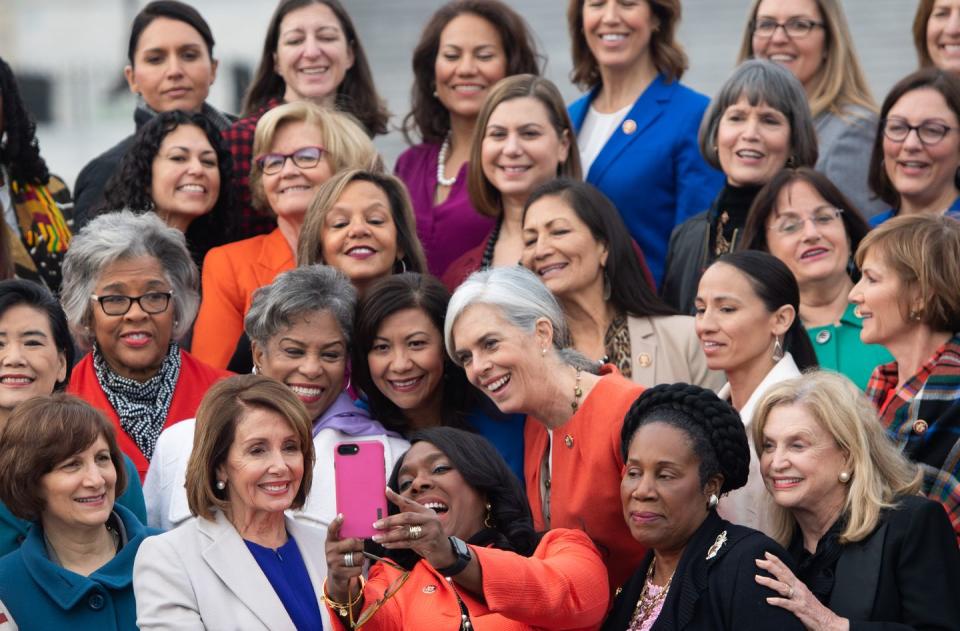After Losing in 2018, These Women Are Ready for a Comeback

Cori Bush thought she was done running for office. In the 2018 midterms, the former nurse and single mother decided to challenge Rep. Lacy Clay, a longtime incumbent in Missouri’s 1st congressional district, the same district where Bush had spent months leading protests against the police killing of 18-year-old Michael Brown. The primary was Bush’s attempt at toppling a political dynasty—Clay and his father had held the seat since the 1960s—and her ambition was featured in Knock Down the House, often nicknamed the “AOC documentary” for its chronicling of Rep. Alexandria Ocasio-Cortez’s ascent to Congress. But Bush lost her race; in the film, you can see her dabbing her eyes as the results roll in. “I was devastated because I really believed I would win,” she told ELLE.com, two years later. While some women made history that midterm season, others like Bush didn’t get their Hollywood ending. So this year, they’re trying again.
If you were to look at the 2020 roster of female federal candidates, you’d likely have some déjà vu. There’s Amy McGrath, who lost her 2018 congressional race, but came back this year to face off against Mitch McConnell for a Senate seat. There’s Young Kim, who narrowly lost her California congressional race in 2018, but returned to challenge the incumbent again. There’s Kara Eastman in Nebraska, Carolyn Bourdeaux in Georgia, MJ Hegar in Texas, and Tedra Cobb in New York.
And then there’s Bush, who came through in a stunning upset when she ran against Clay again in the 2020 primary—and won. “It was like a dream come true,” she said. “That was the first feeling I had: I get to have joy in this moment.”

Political candidates losing a race and then choosing to run again is not a new phenomenon; Barack Obama famously lost his 2000 congressional primary, only to run for Senate in 2004, and then president in 2008. But as the number of women running for office has skyrocketed since 2016, analysts and organizers have taken notice of these Comeback Candidates.
It’s the first election cycle that the Center for American Women and Politics at Rutgers University has published data about these women, citing that “of the total unsuccessful candidates that ran for congressional and statewide offices in 2018, 15 percent are likely to run again in 2020.” Debbie Walsh, the director of CAWP, said the center started to look at the numbers partly because of the highly-visible candidates who returned this year.
“Part of it was we saw some women who we thought really had a shot at winning [this] second time,” Walsh said. She mentions Gina Ortiz Jones’ congressional race in Texas. While Jones lost to the incumbent, Will Hurd, in 2018, she launched another campaign for the seat in May 2019; Hurd announced he wouldn’t be running for reelection three months later. If she succeeds, she'll be the first Filipina-American in Congress and the first out LGBTQ+ congressperson from Texas. “Her race has really changed, and she lost by so little, that coming back was intriguing to us.”
I'm so honored to be endorsed by President @BarackObama!
There is so much at stake in our fight for quality, affordable health care, good jobs, and an economy that works for everyone.
Help share the good news and join our campaign to flip #TX23! https://t.co/krg1k5EI0K pic.twitter.com/XwKFtBi1bV— Gina Ortiz Jones (@GinaOrtizJones) August 3, 2020
Over at EMILY’s List, the political action committee that works to get pro-choice Democratic women into office, nearly 38 percent of their endorsed federal candidates who lost in the 2018 general election came back again to run in 2020.
Returning, after all, can give you an advantage. While you have to be strategic, candidates can take their loss and turn it into a win by using the resources gained in the first campaign: the donors, the name recognition, the volunteers and contacts, the connections to party leaders. And sometimes, circumstances simply shift.
For Bush, this was all part of her success. She first ran for U.S. Senate in 2016 and though she came in second in the Democratic primary, she caught the attention of Brand New Congress, a political action committee started by former Bernie Sanders’ volunteers who were looking to support and elect progressive, diverse candidates.
Then, soon after she lost the primary, she was sexually assaulted. “My mind was gone,” she said. “I couldn’t eat. I couldn’t sleep. I couldn’t cook. I couldn’t take care of my kids. I was spending a lot of time going to court, trying to get some type of justice, which didn’t come.” During her recovery, a friend repeatedly suggested she consider running for the congressional seat in 2018. Bush kept saying no, until former state Rep. Bruce Franks Jr. came to her and said: “You need to do this. I want you to run.”
She came up short, finishing 20 points behind Clay, and figured that was the end. “I just wasn’t prepared,” she said. “There was no ‘what do I do next?’ because I thought next was Congress.” But her team was ready: She found them huddled in a corner at her watch party organizing the next race. “They continued to meet for months. They said they were going to continue on just like I was going to run again, even though I wasn’t coming to any of the meetings.”
Eventually, she came around, partially thanks to unyielding support from her father and kids. “We ramped up and realized some things we didn’t do the way we should have in the last race,” Bush explained. “We were fundraising differently, bringing people on as staff earlier, and staying present in the community.” Vox reports that “Bush and her allies dug in on Clay’s corporate connections,” part of a “core message that helped put Bush over the top.” Isra Allison, the executive director of Brand New Congress, joined her team as campaign manager. She had even more name recognition from Knock Down the House.
But like millions of Americans, Bush contracted COVID-19, leaving her sick for two months. (She was hospitalized twice.) As she began to feel better, George Floyd was killed in Minneapolis, sending the nation into a state of prolonged protest, one that Bush had to join.

In a year of chaos, Bush became a candidate for the moment: “People were able to see that this nurse had been talking about Medicare-for-all for the last four years, talking about not having healthcare connected to job status, now we understand why. Then it was like, ‘Nurses are heroes.’ Also, people saw me being vulnerable. I was talking about my story; I was doing live streams, even though I couldn’t breathe. Then for me to go straight into the protests—the very first march we had, I couldn’t even walk. People saw me coming from the protest and continuing on, that’s the champion they wanted.”
Since Bush’s district—which encompasses cities like St. Louis and Ferguson—is reliably blue, she’s now on track to become the first Black congresswoman in the state. (Ella Jones also made history in the district this year, becoming the first Black woman elected mayor of Ferguson, her own comeback after losing the mayoral race in 2017.) And they weren't the only candidates to succeed this time around: Illinois’ Marie Newman, who lost her congressional primary in 2018, went up against the same incumbent this March and won. Her solidly blue district means that she’ll more than likely join Bush in D.C. next year.
We’ll have to wait to see how some of the other candidates fare, but for an organization like EMILY’s List, the sea change is encouraging. Since Donald Trump was elected, 60,000 women have contacted the organization to say they’re interested in running for office. Stephanie Schriock, president of EMILY’s List, says that win or lose, they’ve always gone back to their candidates to talk about next steps, even sometimes begging them to run again. “In 2018, we had this historic number of women running, we made history with the most diverse class to come to the House of Representatives,” she said. “But we knew that there were some candidates who fell a little short. We called them right afterward. We figured, let’s do our work of convincing these women they should run again.” But something had shifted; they didn’t need to be persuaded. “They were like, ‘We’re going. You don’t need to ask.’”
And those who decided not to? “They had good reasons,” she said. “Family, economics, the seat’s just too challenging.” But there are structural changes that could make the process—one that was originally set up to support rich, white men—easier.

Take Liuba Grechen Shirley, a New York-based candidate who, in April 2018, petitioned the Federal Election Commission to use a portion of her campaign funds for childcare, the first woman to do so. Running a competitive race, which candidates often give up their own income to do, is expensive and part of campaigning is making sure your kids are alright.
At the federal level, Schriock says, as long as you’re not an incumbent, once you’re an official candidate on the ballot, you can draw a minimal salary from your campaign committee. “But it’s really frowned upon,” she explained. “And we need to stop. If you want a diversity of voices, particularly women of color, we’ve got to ensure they’ve got the personal resources to make it. No one’s trying to get rich here, just enough to cover the ability to live while you’re not getting a paycheck... We’ve lost candidates at the legislative level because they personally can’t afford to run.” Bush said, during her 2016 race, it was so financially difficult that she had her utilities shut off.
For Paulette Jordan, these were essential considerations before deciding to run. In 2018, Jordan was the Democratic candidate in Idaho’s governor race; if she had won in the deep-red state, she would’ve become the nation’s first Native American governor. This year, she’s running in the state’s U.S. Senate race, going up against incumbent Jim Risch.
“Like anything else, you worry about your family,” she said. “I’m a single mother of two sons. You’re going to worry about your finances...when you’re campaigning and you’re out fighting for this grander cause, you often leave those you care about more vulnerable.” Jordan used to feel heartbroken when she left her children in order to campaign, but that experience showed her what needed to change: “I definitely keep them close to me this time around. They travel with me everywhere I go, especially during this pandemic.”
Naturally, the more you do something, the better you become at meeting your needs, and the needs of your campaign. “Your start with a completely different foundation underneath you,” Schriock said. “Your starting line has moved way further ahead.”
Yet even Jones, the congressional candidate in Texas who caught Walsh’s eye, admitted: “Running for office is not for the faint of heart.” Just like Bush and Jordan, Jones wasn’t sure at first if she’d come back. “At the end of the day, for me, you’ve always got to be able to look yourself in the mirror and say, ‘Have I done all that I can do?’”
For many, it seems, there’s an obvious answer: A record number of women ran for office in 2018, only for that record to be broken in 2020. And as more women commit to running, more will return as undeterred, seasoned campaigners, using their resources and knowledge—and the changing political landscape—to get closer to the finish line, and closer to a government that actually reflects its constituents.
“I think it’s great that we’re seeing more women step up and run,” Jones said. “I don’t think anybody should be surprised that those that have the most to lose are raising their hand.”
And maybe just as important: They’re refusing to put it back down.
You Might Also Like


